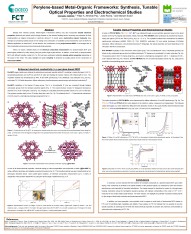resumo
Besides their inherent porosity, Metal-Organic Frameworks (MOFs) may also incorporate tunable electronic properties (electrical and optical) which strongly depend on the selected building blocks, becoming very attractive for their implementation as integral components in electronic devices.[1] In recent years, electroactive organic molecules have emerged as promising building blocks for the design and construction of crystalline porous frameworks such as MOFs for different applications in electronics.[2] In this direction, the construction of new perylene-based MOFs is encouraged due to their remarkable luminescence and promising electrical properties.\r\nHerein, we report a detailed study on the electrical conductivity enhancement of a perylene-based MOF upon partial ligand oxidation by iodine doping using two-probe single-crystal devices. In addition, a new family of perylene-based MOF with different transition metals (Co, Ni, Zn) has been synthesized exhibiting tunable optical properties depending on the nature of the metal. This study highlights the great versatility of perylenes as building blocks for the construction of electroactive MOFs. \r\nIn summary, we have reported the first evidence of increased conductivity in a perylene-based MOF upon iodine doping. This conductivity is ascribed to the partial oxidation of the perylene ligands, as witnessed by EPR and emission spectroscopy, and supported by theoretical calculations. The charge transport is described by means of a through-space hopping mechanism along the herringbone perylene packing, with highest conductivities of the order of 10−5 S·cm−1 measured in two-contact single-crystal devices.[3] For these reasons, we highlight the potential of perylene building blocks for the design of electrically conductive and photoresponsive MOFs. In addition, we have presented a new synthetic route to prepare a novel family of isostructural MOFs based on PTC and TM exhibiting high crystallinity and stability. These studies on PTC-TM indicate that it is possible to tune the optical properties by switching the TM while the electrochemical properties of perylene are preserved, demonstrates by solid-state cyclic voltammetry of PTC-TM.[3]\r\nReferences\r\n[1] M. D. Allendorf, R. Dong, X. Feng, S. Kaskel, D. Matoga and V. Stavila, Chem. Rev., 2020, 120, 8581. [2] M. Souto, K. Strutyński, M. Melle-Franco and J. Rocha, Chem. Eur. J., 2020, 26, 10912. [3] G. Valente et al. 2022, submitted.
autores
Gonçalo Valente, Filipe A. Almeida Paz, João Rocha, Manuel Souto



